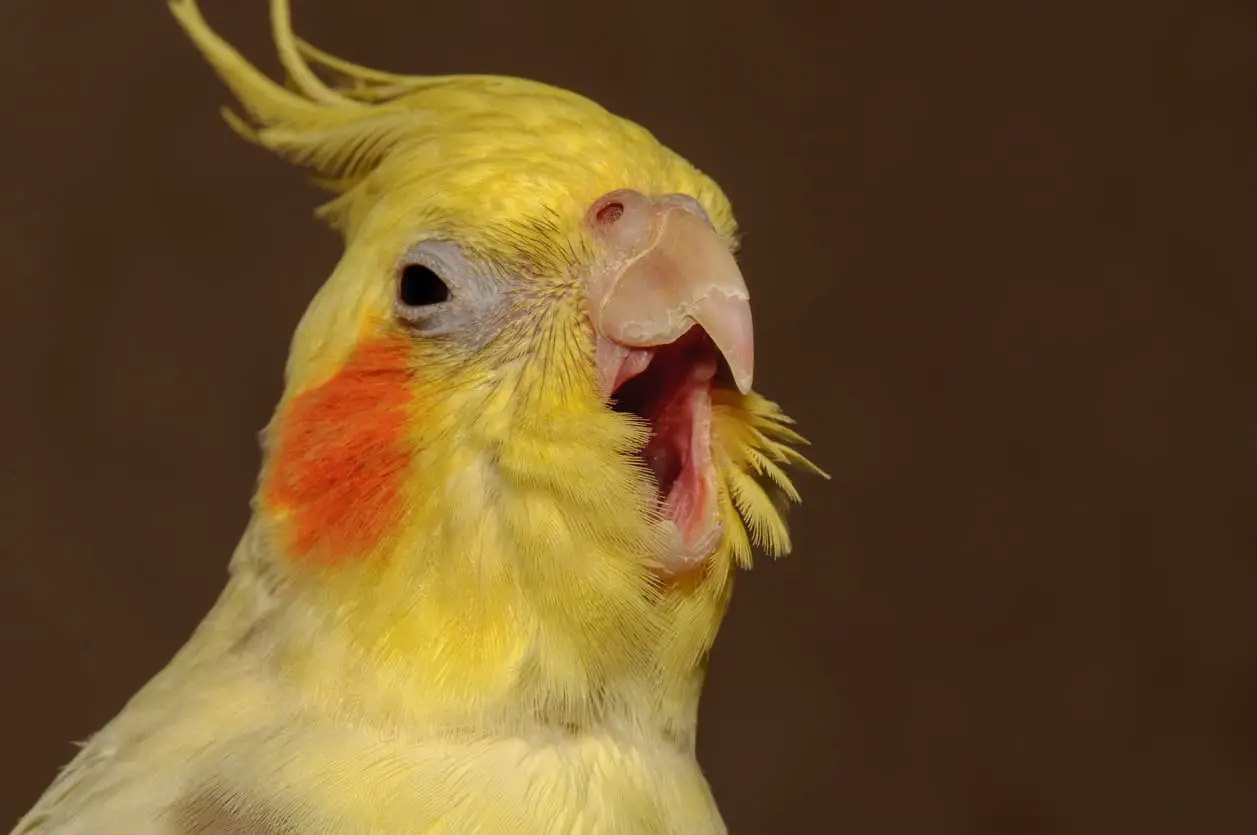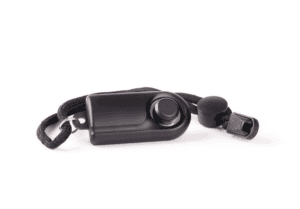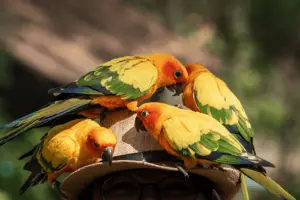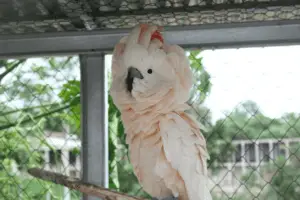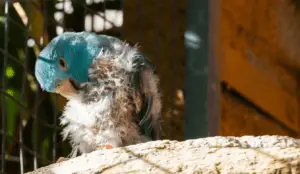Possibly, the most fun you can ever have with a domestic parrot is its ability to mimic different sounds. Most of these species can learn to imitate several tunes and phrases to a certain extent.
Plus, some parrots, like the African gray parrot, have great memories and beautiful voices. They can easily speak and learn a wide range of sounds and words. But what about the world’s second most popular parrot? Can a Cockatiel talk?
Key Takeaways
- Cockatiels are the second most popular parrots on the planet; however, they are not the best talkers.
- But they still can mimic your voice and even learn how to create specific sentences.
- Several factors can affect their rate of learning how to talk. These factors include gender, age, the trainer, and upbringing.
- Before teaching your pet to talk, you must ensure you have tamed and bonded. Scolding and negative training can harm what you have already taught the bird.
Cockatiels are beautiful creatures that are capable of talking. Unfortunately, this parrot’s vocabulary is not as extensive as some top parrot species, like the Amazon parrot and the African gray parrot. However, you can teach your Cockatiel to talk with patience and training.
After the budgie, Cockatiels are the second most popular parrots on the planet that make great pets. So in this article, we’ll answer the question: can cockatiels talk? We’ll also show you how to teach your pet to talk. So let’s dive right in.
Can Cockatiels Talk?
The short answer to this question is yes; cockatiels can talk. But the long answer is yes; they can learn how to speak or imitate other sounds; however, their learning ability will depend on several factors. This video shows how the cockatiel makes phrases and words and makes its own unique sentences.
But most importantly, you should know that they’re not budgies or African gray parrots. Therefore, their voices can be pretty raspy, and they can’t learn long phrases. According to the National Library of Music, these birds can imitate music with their whistle-like vocals.
They can learn even more words and phrases with patience and proper timing. But don’t expect their voice to be as smooth or precise as some top parrots like the Amazon and gray parrots. The rate at which these birds will learn how to talk will depend on the following factors:
Gender
Generally, males tend to produce a more intricate sound than females. And that’s because they use their voices to woo the females during the mating season and warn the flock in case of danger. On the other hand, the females make fewer noises and, in most cases, flock calls. Therefore, males are more likely to learn how to talk than females.
The males are usually more expressive in the wild with movements and sounds when attracting a mate. The females stick to chirping flock calls and producing some natural sounds.
Age
Like human beings, all parrots, including cockatiels, can learn faster while young. Mature parrots may be able to learn, but they’re pretty challenging to train. And that is because they get bored quickly, especially when asked to do several repetitive actions. But the young ones are always eager to learn. Therefore, you can teach the bird more vocabulary.
If you can take your time with a young cockatiel, you can teach it a wide range of vocabulary and phrases.
Upbringing
Generally, hand-raised parrots can learn faster than others. And that’s because they’re more accepting of training; plus, they’re people-oriented and consider you a member of their flock. Once accepted as part of its flock, it will be willing and ready to work with you.
Sure, you can train birds that were not hand-raised, but it will take longer before it even trusts you and learns from you.
The Trainer
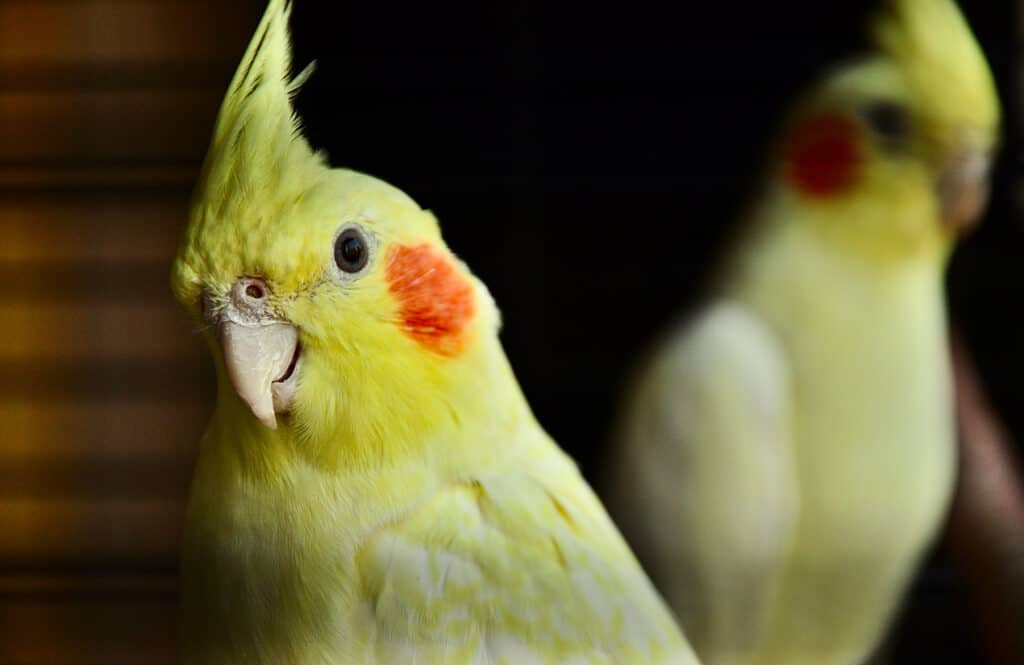
Your patience and time spent training influence your bird’s learning rate if you’re training it. The more time you spend training the bird, the more it will learn and perfect its skills. Your training techniques can also come into play here.
Are Cockatiels Easy To Train?
Cockatiels are social creatures that love spending time with their owners, and once tamed, you can become part of their flocks. When tamed, they can be straightforward to train. They’re easy to potty train and can even learn some tricks.
Like other parrots, patience and daily practice are mandatory when teaching them how to talk. But before you start training your pet, you should ensure it’s comfortable and safe around you. It means you spend more time with your pet and let it adjust to its new home and family before trying to train it. You can even let it spend more time outside of the enclosure.
Positive reinforcement is a crucial element when training the Cockatiel. Remember, positive rewards can be more beneficial than scolding it; scolding it can scare and confuse them.
Training helps strengthen the relationship between you two while improving its well-being and health. According to Vet Med, if training sessions are coercive or uncomfortable, then the entire process may not be effective.
How Do You Teach A Cockatiel To Talk? Follow These Steps
Like most parrots, cockatiels can make excellent pets; teaching them how to talk can be a perfect way for you two to bond. Remember, a talking parrot that repeats some syllables and makes a robotic replica of the noises around it, or words can improve the quality of your bond with the bird.
With time you’ll start to understand what your pet is saying. But you have to teach it before you can get it to talk. Ensure you work with it until it learns and reinforces its vocabulary. To train your pet how to talk, you should do the following:
Make The Bird Comfortable
The first step to any training is getting the pet comfortable and feeling safe in your presence. Remember, a comfortable cockatiel can respond ideally to your requests. Therefore, to make it comfortable, you should do the following:
Bond With Your Cockatiel First
The key to training your pet how to talk is human interaction. Some believe you can train your bird and tame it simultaneously works perfectly, but that is not the case. Instead, you should bond with it first and give the birds time to get used to you and your home before you even start teaching it how to talk.
You can ask your vet for assistance if it’s your first time. The local pet store owner or an experienced friend can help you tame your pet.
Make Sure It Is Well-Fed And Healthy
Another part of making it feel comfortable is providing an enclosure with more than enough space for its perches, toys, and dishes. Make sure you provide it with more than enough water and food.
Remember to give it a balanced diet; if it has any health issues, you can take it to the vet and examine it regularly. It won’t be too chatty if it’s not feeling well. According to Wikihow, you should ensure it’s healthy and happy before training it.
Make Sure That Your Cockatiel Is Happy
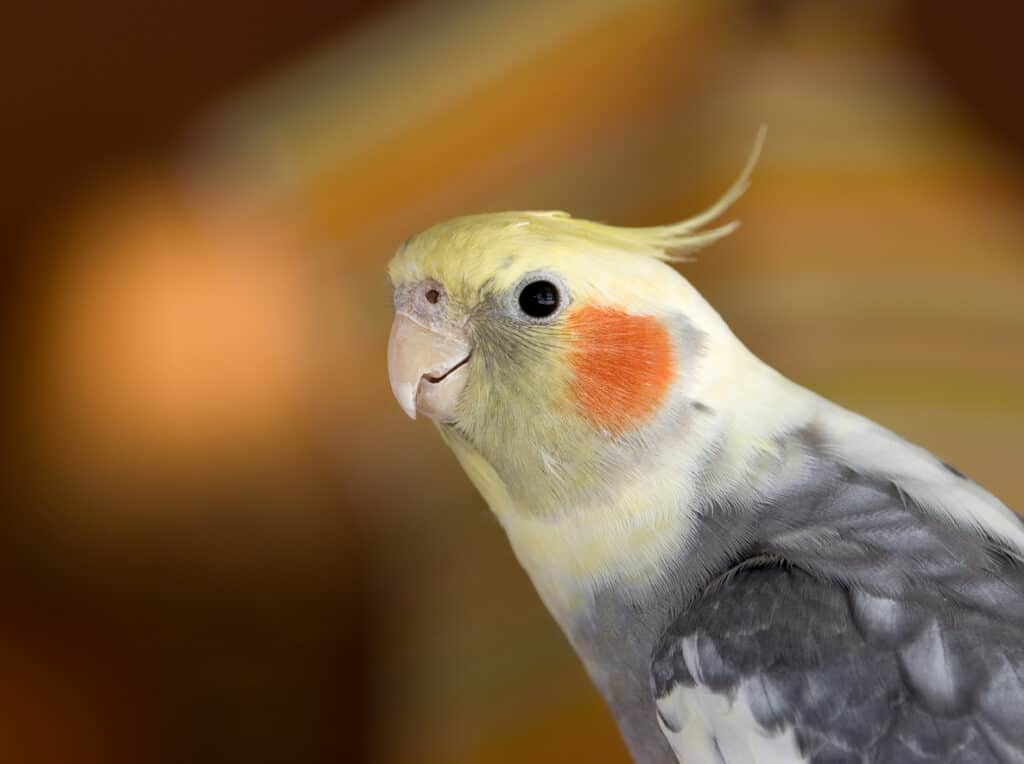
To guarantee it’s always happy, you should give your social bird lots of attention; plus, some mental stimulation teachings can play a significant role in the bird learning how to talk. You can also give it some unique toys.
And if it does it well, you can provide it with affection and praise, primarily when it produces different sounds.
A cockatiel’s brain needs regular mental stimulation to be happy, which means giving it some puzzle games. Next, find out where it’s comfortable or create a peaceful environment where it thrives. When in a relaxed environment, the Cockatiel will be willing to learn new words and improve its vocabulary.
Teach It To Repeat Some Words
As aforementioned, this parrot doesn’t have a sweet voice or the ability to learn words like the budgie or gray parrots. So you shouldn’t expect too much from it or push it towards perfection; instead, you should work with its capabilities. It would be best if you also learned more about the different sounds produced by cockatiels and their meanings.
Learning the different sounds can help you communicate well with your pet. Plus, it can be helpful if you don’t understand its body language. To train it how to talk, you should do the following:
Train The Cockatiel In A Very Quiet Place
You need to work in a tranquil room for your pet to learn and even focus on what you’re doing. Remember, these birds can easily get distracted, affecting the training sessions. So if possible, you should remove both visual and sound distractions. Getting rid of distractions can be beneficial and even hasten the learning process.
Introduce Your Cockatiel To A Single Phrase At A Time
The best way to teach your pet to talk is by starting with simple but common phrases or words. Try to keep the terms easy and short, but most importantly, it should be a word you use regularly.
For instance, you can teach it its name, ensure it gets used to it, and even respond. If you don’t want to teach it its name, pick a simple phrase of one or two words with high pitches.
Since the Cockatiel has a high-pitched voice, you cannot teach words usually pronounced in low tones. Another critical factor you have to do is use the phrase at the right time. If it’s morning, you can teach it to say good night; in the evening, you can teach it to repeat evening or good night.
Focus On The Phrases That Your Pet Likes
After teaching it several phrases, you should pick the ones it likes and focus on them. So when saying several high-tone words, you should look at its pupil, and if they enlarge when you say these words, it means they like them. If your pet doesn’t respond, it doesn’t like the phrases, so you may have to pick other words.
Your bird might not repeat certain words for one reason or the other. It may be that the words are simply too hard for the pet to understand and repeat them. Remember, some low-tone words can be challenging for them, and they may not be physically able to pronounce these words.
Use Positive Reinforcement
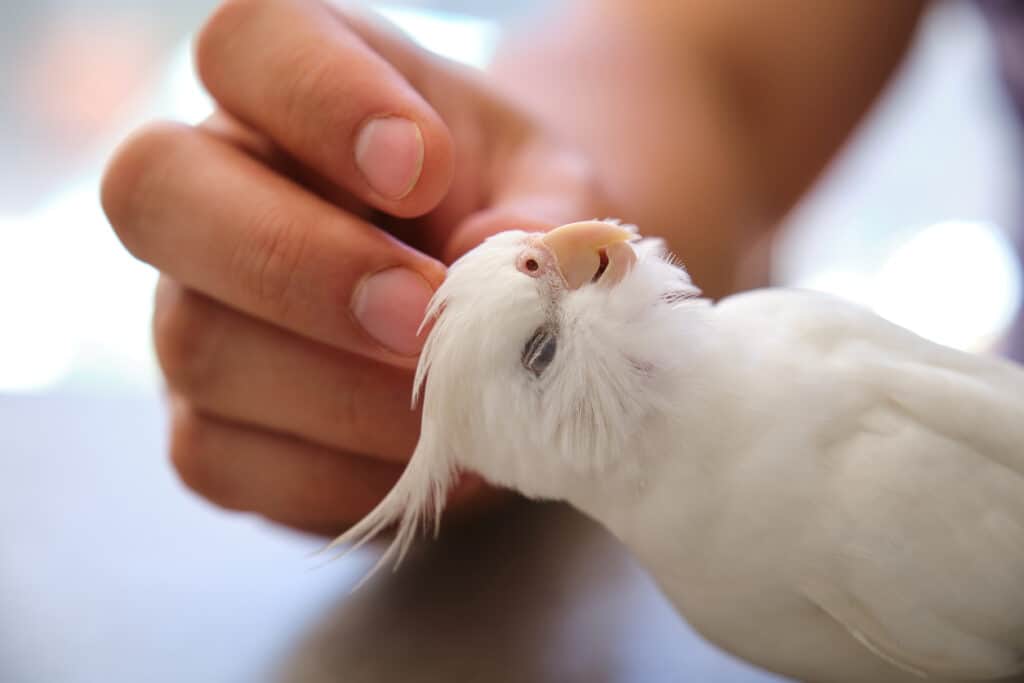
You can strengthen the repeating behavior using positive reinforcement. It means giving your pet some treats every time it does something correctly. Some affection and attention can also come in handy when they pronounce some words correctly. Treats will help them associate talking with something positive, and your attention will urge them to learn more.
Depending on your preference and choice of treats, you can give it special treats designed for parrots or even human food. When feeding human food to your cocktail, ensure it can have the food. You don’t want to give your bird something toxic or poisonous.
Repeat The Phrases And Be Very Patient
Irrespective of your pet’s intelligence level, it’s not Einstein, so you should be ready to repeat those phrases several times. So you must be patient with your pet and try to bond with it while learning.
Impatience can leave your pet frightened of you, and it can even lose interest in the training. Scolding or a single hand gesture can undo all the progress made.
So you should find ways to make it enjoyable to prevent boredom. Remember, a mature parrot can easily get distracted; on the other hand, the young parrot will be eager to learn, but you’ll have to be very patient with it.
Learning how to talk can be a bit challenging, so you will have to be patient. It would help if you also understood how it pronounces words using its raspy voice and mixing words with some vocalization like whistling.
Complicate The Phrases After It Has Learned The Simple Ones
Once your pet has perfected the simple words you have been teaching, you should introduce and complicate them. As soon as it responds to its name, you can try and mix things up. Even with the tricky words, you should use positive reinforcement and treats. But most importantly, you must be even more patient than simple words.
You can start by narrating what you’re about to do to it. For instance, if you want to remove it from its cage, you can say,” want to leave the enclosure and play” or “do you want a treat.” When you do this more often, your parrot will start liking it and even say some of these phrases.
It may start saying, “leave the cage,” as soon as it sees you coming to its location and ready to play. Repeating this will teach your pet to speak when spoken to. For instance, this parrot has learned to say,” you’re so cute,” and it can repeat it to its owners.
You can also try whistling while in the same room with your Cockatiel. You can repeatedly start with a series of simple notes to teach it to whistle some songs. If lucky, your pet will learn it and start repeating it. However, in some cases, your Cockatiel may favor whistling over speaking; it is way easier for them.
How Long Will It Take For The Cockatiels To Learn How To Talk?
There is no straight answer to this question, and it is determined by a number of the factors that we have mentioned above. You will require a lot of patience to teach your pet how to talk. Unfortunately, there is no set amount of time for this to happen. It might take a few days, weeks, or even months.
On the other hand, some cockatiels will prefer to sing instead of talk. Some will even mimic certain noises in the environment.
Conclusion
Despite its raspy voice, a cockatiel can talk; folks who have owned it for years can tell you the fun of talking to your pet. You have to be very patient with this species. For instance, you should start by bonding it and ensuring it’s comfortable.
Once comfortable, you can start with simpler words, like its name and other small words that you usually use around the bird. After it gets used to its name, you can introduce it to some tricky characters. But you have to be patient with it when it comes to teaching it challenging phrases. With time it will perfect its speech.
- YouTube contributor, Talking cockatiel pretty bird conversation,https://www.youtube.com/watch?v=HSnav23MKKo/ Accessed March 24, 2023
- Yoshimasa Seki et al., Cockatiels sing human music in synchrony with a playback of the melody,https://www.ncbi.nlm.nih.gov/pmc/articles/PMC8415583/ Accessed March 24, 2023
- Training your parrot,https://vetmed.tamu.edu/news/pet-talk/training-your-pet-parrot/ Accessed March 24, 2023
- Pippa Elliot, How to Train a Cockatiel to Talk,https://www.wikihow.com/Train-a-Cockatiel-to-Talk/ Accessed March 24, 2023
- YouTube contributors, Cockatiel sounds and their meanings! The parrot teacher,https://www.youtube.com/watch?v=5dTW-qHnq08/ Accessed March 24, 2023
- YouTube contributor 5mo Talking Cockatiel saying,” You’re so cute!” https://www.youtube.com/watch?v=PDqxYC67t60/ Accessed March 24, 2023

